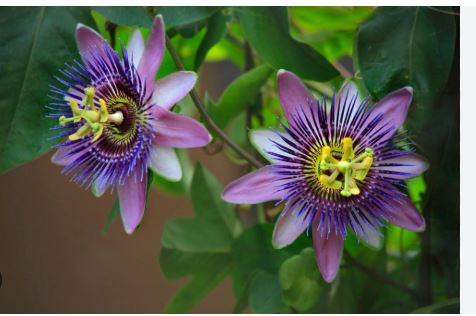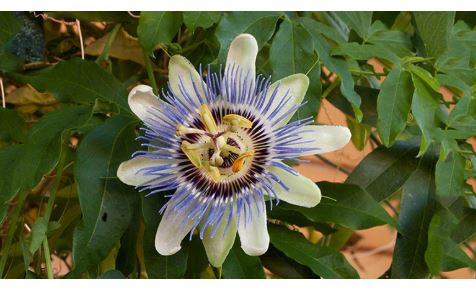
Passionflowers, belonging to the genus Passiflora, are a diverse group of over 550 species, primarily climbing vines, with some shrubs and trees, native mostly to the Americas. Renowned for their exotic, intricate blooms, they are popular in gardens for their ornamental appeal and, in some cases, edible fruits. These fast-growing plants add tropical flair to trellises, arbors, or fences, thriving in warm climates.
Passionflowers typically feature slender, twining stems with spiraling tendrils that aid climbing, reaching lengths of 6–40 feet depending on the species. Their leaves are usually glossy, often lobed (three to five lobes) or unlobed, ranging from deep green to variegated, providing lush foliage even when not in bloom.
The hallmark of passionflowers is their complex, radial flowers, ranging from 1–6 inches in diameter. Blooms display layered petals and sepals, often in white, purple, red, or yellow, with a prominent corona of thread-like filaments in contrasting colors. A central column of stamens and stigmas adds to their striking, almost otherworldly appearance, blooming primarily in summer.
Many passionflower species produce round or oval fruits, ranging from small, inedible berries to larger, edible passionfruits with juicy, seed-filled interiors. Fruit colors vary from green to yellow, orange, or purple, with flavors from tart to sweet, depending on the species. Not all species yield edible fruits, but those that do are prized in culinary applications.
Passionflowers thrive in full sun to partial shade, preferring well-drained, fertile soils with moderate moisture. Most are hardy in USDA zones 6–11, though some require tropical conditions (Zones 10–12). They need support structures like trellises and benefit from regular pruning to control growth and encourage flowering.
These versatile plants are ideal for covering fences, pergolas, or walls, creating vibrant vertical displays. They attract pollinators like bees and butterflies, enhancing garden biodiversity, and some species support butterfly larvae. In colder climates, they can be grown in containers or as annuals, bringing exotic beauty to diverse garden settings.

Cultivars of Passionflower (Passiflora)
Passiflora caerulea (Blue Passionflower)
This vigorous, semi-evergreen vine grows 10–30 feet, with glossy, five-lobed, dark green leaves and spiraling tendrils. Its striking 3-inch flowers, blooming July to October, feature white petals, a ring of blue-white-purple filaments (corona), and a central column of stamens and stigmas. Orange, egg-sized fruits follow, edible but bland. Hardy to Zone 6, it’s ideal for trellises or fences in full sun.
Passiflora incarnata (Maypop)
A fast-growing, herbaceous perennial vine reaching 10–30 feet, native to the southeastern U.S., with three-lobed, dark green leaves. Its 3–5-inch lavender to purple flowers, blooming May to July, have a wavy corona of pinkish-purple filaments over white petals and sepals. Yellow, egg-shaped fruits (“maypops”) are edible. Hardy to Zone 5, it suits sunny borders or arbors.
Passiflora edulis (Purple Passionfruit)
This tropical, evergreen vine, 15–20 feet long, has three-lobed, glossy green leaves. Its 2–3-inch flowers, blooming summer to fall, display white petals with a vibrant purple-white corona and a prominent androgynophore. The round, purple fruits are juicy and tangy, widely used for passionfruit juice. Best in Zones 9–11, it needs full sun and well-drained soil.
Passiflora vitifolia (Crimson Passionflower)
A vigorous, evergreen climber to 20 feet, native to Central America, with broad, three-lobed, grape-like green leaves. Its stunning 6-inch crimson-red flowers, blooming summer to fall, have yellow filaments and a compact corona, creating a bold display. Edible but tart fruits follow. Suited for Zones 10–11, it thrives on trellises in sunny spots.
Passiflora lutea (Yellow Passionflower)
A delicate, smaller vine, 10–15 feet, native to the southeastern U.S., with three-lobed, medium green leaves. Its dainty 1-inch greenish-yellow flowers, blooming summer to fall, have a subtle corona and small purple fruits. Hardy to Zone 5, its understated charm suits naturalistic gardens or small trellises in partial shade.
Passiflora alata (Winged-Stem Passionflower)
This robust, evergreen vine, 10–20 feet, has winged stems and large, three-lobed, glossy green leaves. Its 4–5-inch flowers, blooming summer to fall, feature crimson petals with purple-white filaments, exuding a strong fragrance. Fruits are rarely edible. Ideal for Zones 9–11, it’s a showy choice for pergolas in full sun.
Passiflora quadrangularis (Giant Granadilla)
A massive, evergreen vine to 40 feet, with broad, heart-shaped, glossy green leaves. Its 4–5-inch flowers, blooming in warm weather, have red to purple petals with a white corona. The large, gourd-like fruits, up to 8 pounds, are edible but mild. Suited for Zones 10–12, it needs ample space and support.
Passiflora foetida (Stinking Passionflower)
This fast-growing, herbaceous vine, 10–15 feet, has three-lobed, sticky leaves that emit an odor when crushed. Its 1–2-inch greenish-yellow to white flowers, blooming summer to fall, have a lacy corona and small, red to yellow edible fruits. Hardy to Zone 8, it’s a quirky addition to butterfly gardens.
Passiflora ‘Constance Elliott’ (White Passionflower)
A cultivar of P. caerulea, this semi-evergreen vine grows 10–20 feet with five-lobed, rich green leaves. Its fragrant, 3-inch pure white flowers, blooming July to October, have a white corona with blue tips, followed by orange fruits. Hardy to Zone 6, it’s stunning on fences or arbors in full sun.
Passiflora laurifolia (Water Lemon)
This evergreen vine, 15–20 feet, has unlobed, glossy, oval green leaves. Its 3–4-inch flowers, blooming in warm seasons, feature purple to white petals with a vibrant purple-white corona. The oval, yellow fruits are sweet-tart and edible. Best in Zones 10–11, it thrives in sunny, well-drained spots near trellises.
Passiflora actinia
This evergreen vine, reaching 15–25 feet, has glossy, three-lobed, dark green leaves. Its 3–4-inch flowers, blooming summer to fall, feature white petals with a vivid blue-violet corona and a central column of yellow stamens. Small, orange-yellow fruits follow, edible but tart. Hardy to Zone 8, it thrives on trellises in full sun or partial shade.
Passiflora coccinea (Scarlet Passionflower)
A vigorous, tropical vine growing 10–20 feet, with broad, unlobed, glossy green leaves. Its vibrant 4-inch scarlet-red flowers, blooming summer to fall, have a short, white-purple corona and yellow stamens. The yellow fruits are edible but bland. Best in Zones 10–11, it’s a bold choice for sunny arbors.
Passiflora racemosa (Red Passionflower)
This evergreen climber, 10–15 feet, features three-lobed, shiny green leaves. Its 3–4-inch deep red flowers, blooming summer to fall, hang in racemes with a simple white corona and yellow stamens, creating a dramatic effect. Fruits are small and rarely edible. Suited for Zones 10–12, it loves warm, sunny spots.
Passiflora manicata (Red-Yellow Passionflower)
Growing 10–20 feet, this evergreen vine has three-lobed, dark green leaves. Its 3-inch flowers, blooming summer, display bright red petals with a striking yellow corona and purple banding. Small, green fruits are inedible. Hardy to Zone 9, it’s ideal for trellises in full sun with well-drained soil.
Passiflora ligularis (Sweet Granadilla)
This fast-growing vine, 15–20 feet, has heart-shaped, glossy green leaves. Its 3–4-inch flowers, blooming in warm seasons, feature white petals with purple-white filaments and a green center. The orange, round fruits are sweet and edible. Best in Zones 9–11, it thrives in sunny, moist conditions.
Passiflora ‘Lady Margaret’
A hybrid vine, 10–15 feet, with three-lobed, deep green leaves. Its 3-inch flowers, blooming summer to fall, showcase deep crimson petals with a white-tipped purple corona, offering a rich contrast. Orange fruits may follow. Hardy to Zone 9, it’s stunning on fences or pergolas in full sun.
Passiflora membranacea
This slender, evergreen vine, 10–20 feet, has unlobed, elongated, glossy green leaves. Its small, 1–2-inch pale green to white flowers, blooming summer, feature a delicate corona and are followed by small, inedible fruits. Suited for Zones 9–11, it’s perfect for smaller trellises in partial shade.
Passiflora antioquiensis (Banana Passionflower)
Growing 10–15 feet, this evergreen vine has narrow, lance-shaped green leaves. Its 3-inch vibrant red flowers, blooming summer to fall, have a pinkish corona and yellow stamens, with elongated, banana-like yellow fruits that are edible. Hardy to Zone 10, it prefers warm, sunny spots.
Passiflora caerulea ‘Clear Sky’
A cultivar of P. caerulea, this 15–25-foot vine has five-lobed, glossy green leaves. Its 4-inch flowers, blooming July to October, are white with a blue-purple corona, larger and more robust than the species, followed by orange fruits. Hardy to Zone 6, it’s ideal for sunny fences.
Passiflora citrina
A compact, evergreen vine to 10 feet, with narrow, two-lobed, bright green leaves resembling butterfly wings. Its small, 1–2-inch bright yellow, star-shaped flowers bloom continuously in warm climates, with no edible fruit. Suited for Zones 9–11, it’s charming in containers or small trellises.
Passiflora trifasciata
This delicate, climbing vine, 6–10 feet, has unique, three-lobed leaves with creamy white veins and purple undersides. Its small, 1-inch creamy white flowers, blooming summer, have a subtle corona, followed by tiny, inedible purple fruits. Hardy to Zone 9, it’s perfect for shaded trellises or as a foliage accent.
Passiflora morifolia (Woodland Passionflower)
A smaller vine, 6–15 feet, with three-lobed, dull green leaves. Its 1–2-inch blue to purple flowers, blooming summer, feature a white corona with purple banding, followed by small, blue-black inedible fruits. Hardy to Zone 8, it suits naturalistic gardens in sun or partial shade.
Passiflora tenuiloba
This delicate, herbaceous vine, reaching 6–10 feet, has slender, three-lobed, dark green leaves with a slightly mottled appearance. Its small, 1-inch star-shaped flowers, blooming summer to fall, are greenish-yellow with a subtle corona, followed by tiny, inedible black fruits. Hardy to Zone 8, it’s ideal for small trellises or rock gardens in full sun.
Passiflora ‘Amethyst’ (Lavender Lady)
A vigorous hybrid vine, 10–20 feet, with three-lobed, glossy green leaves. Its 3–4-inch flowers, blooming summer to fall, feature rich lavender-purple petals and a matching corona with white tips, creating a striking display. Orange fruits may follow. Hardy to Zone 9, it thrives on sunny arbors or fences.
Passiflora miniata
This tropical, evergreen vine, growing 15–25 feet, has broad, three-lobed, deep green leaves. Its vibrant 4-inch scarlet-red flowers, blooming summer to fall, have a compact white corona and yellow stamens, followed by small, inedible fruits. Suited for Zones 10–11, it’s a bold choice for warm, sunny pergolas.
Passiflora x violacea (Violet Passionflower)
A hybrid vine, 10–15 feet, with three-lobed, glossy green leaves. Its 3–4-inch flowers, blooming summer, display deep violet petals with a white and purple corona, exuding a subtle fragrance. Fruits are rare and inedible. Hardy to Zone 9, it’s perfect for trellises in full sun or partial shade.
Passiflora loefgrenii (Garlic Passionflower)
This slender, evergreen vine, 10–20 feet, has three-lobed, glossy green leaves. Its 3–4-inch lavender-blue flowers, blooming summer, feature a long, fringed corona and yellow stamens, with a faint garlic scent when crushed. Small, inedible fruits follow. Suited for Zones 9–11, it grows well in sunny, well-drained spots.
Passiflora maliformis (Sweet Calabash)
A fast-growing vine, 15–25 feet, with unlobed, heart-shaped, glossy green leaves. Its 2–3-inch flowers, blooming summer, have greenish-white petals with a purple-white corona, followed by small, round, edible purple fruits with a juicy, sweet-tart flavor. Best in Zones 10–12, it thrives in warm, sunny conditions.
Conclusion
These Passiflora varieties offer a range of flower sizes, colors, and growth habits, ideal for adding tropical elegance to gardens. Most thrive in full sun to partial shade, well-drained soil, and require support like trellises or arbors. Ensure proper hardiness zone compatibility (5–12) and provide winter protection in colder regions for optimal growth.